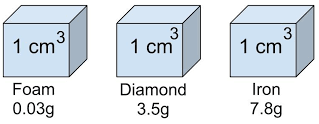Exam questions on density often involve several concepts. This includes; calculating density, comparing densities of different substances, or understanding how density relates to buoyancy and floating. Density is a measure of how much mass is packed into a given volume. It’s calculated by dividing an object’s mass by its volume.
Exam Questions on density
1.(a) The level of water in a measuring cylinder rises from the 50 cm3 mark to 55.7 cm3 marks when a metal block weighing 45 g is submerged in the water in the cylinder.
(i) Calculate the density of the metal block
(ii) State two differences between density and relative density.
2. (b) In an experiment to determine the density of solid S which is not soluble in water. A student obtained the following;
-Mass of empty density bottle= 20 g
-The Mass of density bottle when full of water =45 g
-Mass of density bottle with small quantity of solid S =152 g
-Mass of density bottle with small amount of solids S topped up with water =167 g.
Given that the density of water is 1 g/cm3.Find;
i. The volume of the density bottle
ii. The mass of the solid S
iii. The volume of the solid S
2. The volume of a solution was measured as below. If the mass of solution is measured to be 60.75 grams, what is the density of the solution? (2 marks)

3. What is the mass of a cylinder of lead that is 2.50 cm in diameter, and 5.50 cm long. The density of lead is 11.4 g/cm3.
(i) Calculate the volume in two decimal places of the cylinder. Take π=3.14 (3 marks)
(ii) Determine the mass of the cylinder. Leave your answer as a whole number. (3 marks)
4. Exam questions on density
4. The mass of an empty density bottle is 20 g. Its mass when filled with water is 40.0 g and 50.0 g when filled with liquid A.
(i) Determine the mass of water in kilograms. (3 marks)
(ii)Find the mass of liquid A (in kilograms). (3 marks)
(iii) Find the volume of water. (2 marks)
Calculate the density of liquid A if the density of water is 1,000 kgm-3. (2 marks)

